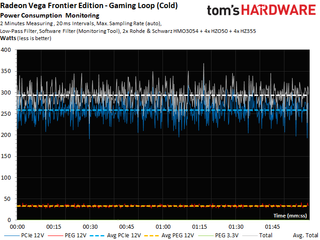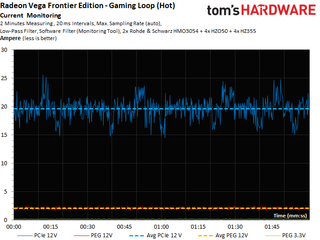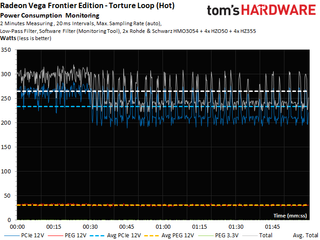AMD Radeon Vega Frontier Edition 16GB Review
Why you can trust Tom's Hardware
Power Consumption
Idle & Professional Application Power Consumption
The Radeon Vega FE uses 14W at idle, according to our measurements. That's not as good as we were hoping for, but it's still solid.
We're annoyed by power use in multi-monitor configurations, though. Consumption varies wildly when more than one display is attached, from approximately 24W for two identical monitors to a massive 40W when you connect three different ones.
When running professional applications, power consumption ranges from ~140W for 2D drawing and 3D wireframes to almost 250W under OpenGL. Finally, it jumps all the way to 265-275W for rendering, depending on the GPU’s temperature.

Gaming Power Consumption – Cold & Hot
Power consumption in games changes depending on the GPU's temperature and clock rate, of course. When the Radeon Vega FE is cold, it consumes almost 300W. Very brief peaks can hit 380W. This isn't a big deal, though: any reasonably modern PSU's secondary side should be able to handle those spikes.

The current measurements look just like you’d expect:

Due to GPU frequency throttling, the Radeon Vega FE’s power consumption drops to 266W once Vega 10 hits its 84°C temperature target. This evens out the corresponding graph a bit:

Naturally, the current readings come in a bit lower as well.

Stress Test Power Consumption
The following graph shows how Power Tune reacts once it predicts too-high of a load. The clock rate control intervals and the effect that throttling has on the card’s power consumption are easily identifiable. The up-and-down cycles look completely different than the shape of the curve did when the GPU was still under full load.

Once again, our current measurement results fit the power consumption ones:

Motherboard Slot Load

Ever since the launch of AMD's Radeon RX 480, there has been demand for this measurement every time a new card is introduced. This time around, there's no cause for concern. The motherboard slot’s 2.7A maximum doesn’t even amount to half of the specified ceiling.
MORE: Best Graphics Cards
MORE: Desktop GPU Performance Hierarchy Table
MORE: All Graphics Content
Current page: Power Consumption
Prev Page Vulkan/OpenGL 4.5 Gaming Performance Next Page Frequency, Temperature & NoiseStay on the Cutting Edge
Join the experts who read Tom's Hardware for the inside track on enthusiast PC tech news — and have for over 25 years. We'll send breaking news and in-depth reviews of CPUs, GPUs, AI, maker hardware and more straight to your inbox.
-
Ne0Wolf7 Too bad its been so well optimized for Creo, I hate that one... Anyways, is it possible to include Autodesk Inventor in the suite? I want a card that can be used as a hybrid like this (of course I'll have to wait for it to come down in price) but its hard to decide I want something if my main software is not included in the benchmarks. Either way, I'm exited and this is a good reviewReply -
cknobman Not sure what to think here (in regards to hopes for the fx versions).Reply
I cannot expect to see a huge % boost in games just on a driver update. Maybe 10% tops?
What bothers me the most is the heat/power and throttling concerns.
I dont think those will change with a fx version of the card.
So it would appear that 80-90% of the time Vega 64 will be running closer to 1200mhz, which is a major bummer and why it wont surpass a 1080.
Almost wish there had been a review of the watercooled version as well to see if it was able to maintain higher avg mhz. -
cats_Paw Dont know much about workstation so my comment does not take that into consideration.Reply
It seems like it eats a lot of power for a very similar performance to a 1080 in gaming but at the same time its faster than Titan Xp in some workstations?
Doesn't that suggest driver/optimization issues? -
Yarvolino Ho comes that Vega and 1080Ti specs are pretty much the same, even greater numbers for Vega, and the result is that Vega is 40% slower and it drains +50% of power ?Reply
Considering Vega also costs much more, I label it as an april fool -
LORD_ORION Wow, what a horrible review.Reply
2 games, 1 resolution... and just where does this card fit in the vega lineup? You didn't even list the details of the other vega cards in a handy chart for comparison.
*starts looking for reviews on other sites* -
demonsoldier So there has been a few people tackling this and i found that lowering certain things about the card undervolting by 110mv has found to fix the clock speed issue keeping at a stable 1600 mhz with better cooling and it out performs the 1080 at that point. Can you guys do a second attempt at this with undervolts to see if that helps anything? AMD cards have been this way everytime they come out needing to have power draw issues fixed later on.Reply -
sparkyman215 Reply20013128 said:Wow, what a horrible review.
2 games, 1 resolution... and just where does this card fit in the vega lineup? You didn't even list the details of the other vega cards in a handy chart for comparison.
*starts looking for reviews on other sites*
wh-what? Toms stated like four times that this *is not a gaming card* and shouldn't be treated as one. They simply included the gaming benchmarks to be inclusive. Also, there's not really a point in showing benchmarks under 4k for such high end cards, because at that point (like 1080p) it's a CPU bottleneck - the GPU has nothing much to do. Considering listing other Vega cards, those are in a different class and not relevant, however it would be nice to have the details of the other cards, I guess. -
yeeeeman Even though AMD says with each ocassion that this graphics card is not indicative of RX Vega's performance I would say that they are trying to avoid early dissapointment. The matter of the fact is that whatever feature they have disabled right now on Vega FE, it won't bring too much performance on RX Vega. Lets face it, if they were using half of CUs on Vega FE, then I would expect huge gains from RX Vega, but as it stands, RX Vega wil be ~ GTX 1080, one year later, + 100W and hot like a stove.Reply
I really wonder how could they make a new GPU on a big better process (28nm vs 14nm) and still get more power consumption compared to Fury X. What is more surprising is that they have the same number of CUs, approx same performance with Fury X, a lot more transistors, a lot more frequency and still the improvement is minimal.
They are either hiding some huge block which doesn't do anything in graphics scenarios which consumes a lot of power just idling or they are rubbish at power optimization or maybe the HBM2 consumes a lot of power, don't know.
Everything on this card is strange, starting with performance, specs, power consumption, everything... -
Pompompaihn Seems like a very nice card if you're a home office person and need your system to do double duty. Good enough for high end gaming and comparable to expensive NVIDIA pro cards.Reply
